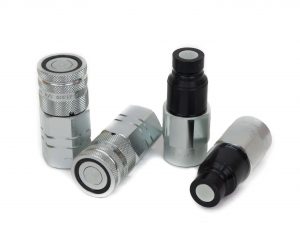 Quick couplings are an important tool for all activities that use hydraulic circuits, found in everyday operations. Oil & Gas, Earth moving, industrial, transportation and agricultural applications use quick couplings to change attachments effectively and safely.
Quick couplings are an important tool for all activities that use hydraulic circuits, found in everyday operations. Oil & Gas, Earth moving, industrial, transportation and agricultural applications use quick couplings to change attachments effectively and safely.
These quick connect mechanisms have been specially designed to perform coupling and decoupling procedures without the use of tools and without causing leakage or contamination. Hydraulic fittings in these applications must stay extremely sound when under pressure, despite the ease with which the hydraulic circuit may be opened. Preventing leakage of fluid at high pressure is critical to prevent potential danger to operators.
Quick couplings designed to be extremely resistant and durable are a wise investment, providing many cost saving benefits. High quality quick couplers reduce the costs of spare parts, equipment downtime and accidents at work. Improper use and maintenance, however, compromise efficiency and may cause accelerated wear. High performance levels of quick couplings can be guaranteed only if:
- They are used according to guidance laid out on the technical data sheet, such as dynamic fluid pressure and degree of resistance to corrosion of the material in relation to the environmental conditions in which it is used
- Maintenance is carried out according to the methods and intervals indicated by the manufacturer
Quick Coupler Cleaning and Maintenance Tips
1) Clean coupling zones and use protective caps
A little attention and preventive maintenance during daily use will extend the lifetime performance of hydraulic quick couplings. Prior cleaning of the coupling zones and use of suitable protective caps is such a small cost in terms of effort and time, although makes a significant difference in terms of long term performance and durability.
2) Do not use tools which may cause damage and leaks
Quick couplings are designed to operate without the need for other tools, which may cause damage and compromise functionality. Release of residual pressure, in particular, must be entrusted to the appropriate mechanisms since external intervention will cause unwanted leakage and possible contamination of the ground.
3) Follow periodic maintenance checks
Checks are to be carried out periodically with an interval that will depend on the application to pre-empt complications during use.
Recommended maintenance includes the following:
- thorough cleaning of external components
- lubrication of coupling zones or moving parts with oil/grease compatible with the specific seals
- coupling and decoupling tests
- check of correct tightening torque of adapters
- check of both coupled and decoupled seal
- check of degree of hydraulic contamination of circuit
4) Timely replace quick couplers as needed
Based on the results of the tests, replacement of the quick coupling should be assessed and planned well in advance so as not to cause interruption to daily operation due to inefficiency or wear of the component.
Stucchi Offers Complete Quick Coupler Solutions
Stucchi has been designing quick couplings for over 60 years, providing a continuous flow of solutions and innovation. The end user can depend on both the quality of the component as well as full support. Detailed instructions and guidance accompany each of our products to convey best practices and provide maximum value. There are a number of online educational and informative resources, including an e-learning platform and a troubleshooting area with an exhaustive list of possible cases.
Stucchi customer support is available for any other information not covered and to answer any of your questions. We are committed to providing leak-free, failsafe quick coupler solutions to our customers. Contact us to find out more about our products and hydraulic solutions.
This post first appeared here: https://www.stucchigroup.com/en/maintenance-how-to-keep-quick-couplings-in-tip-top-condition/